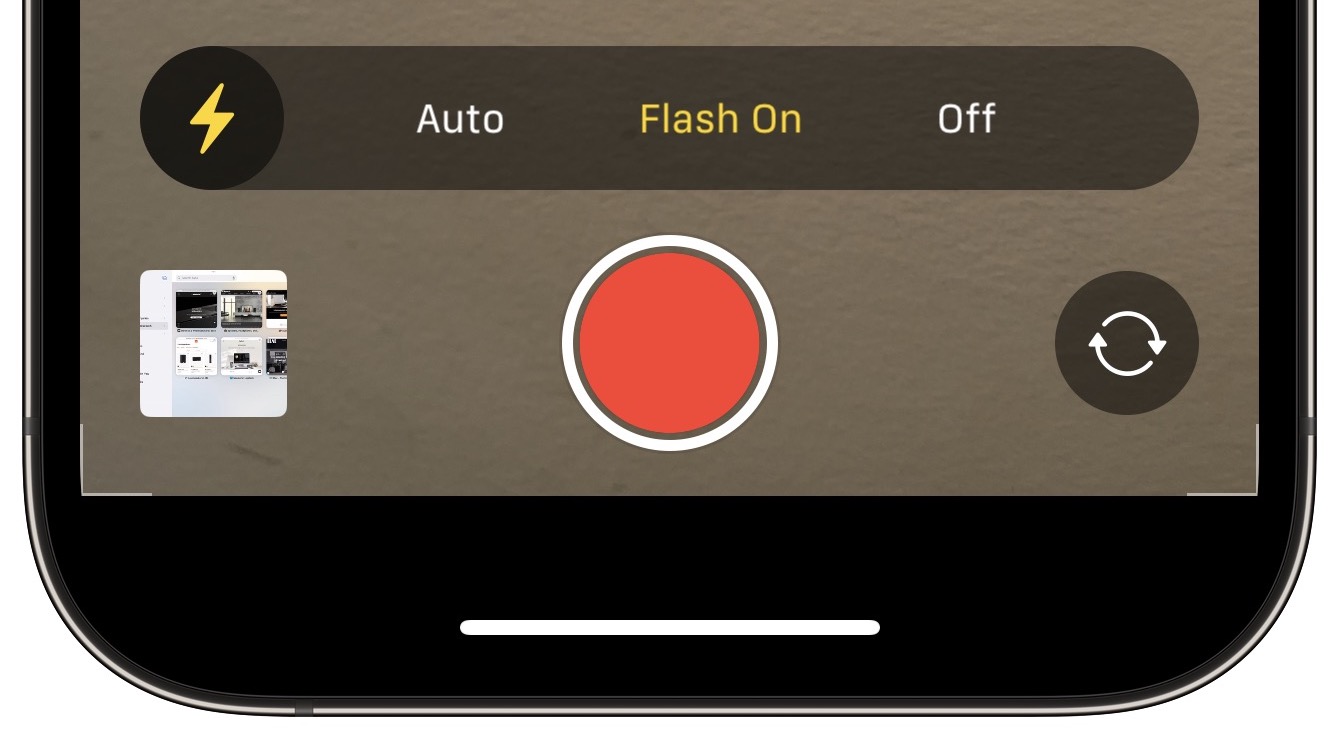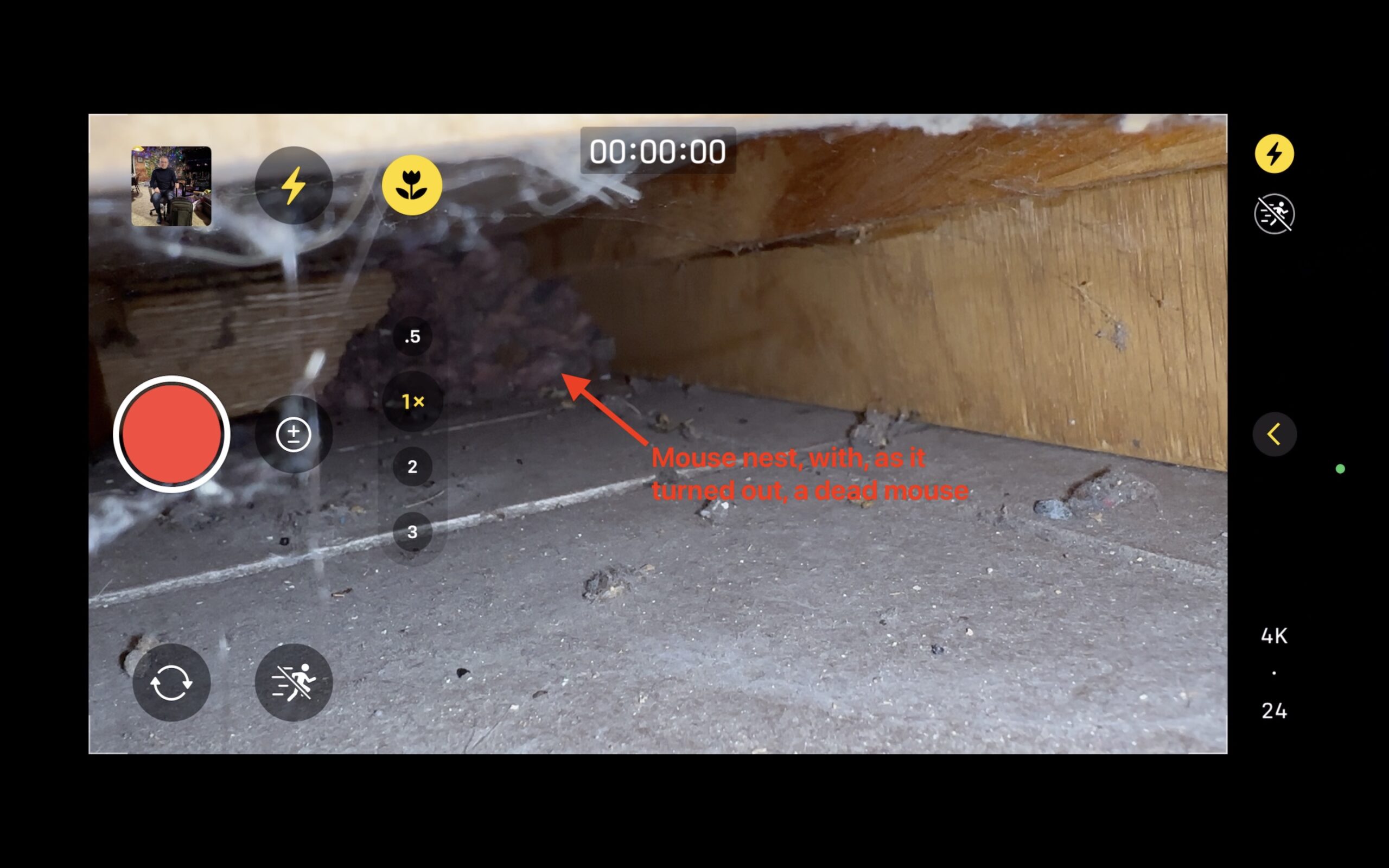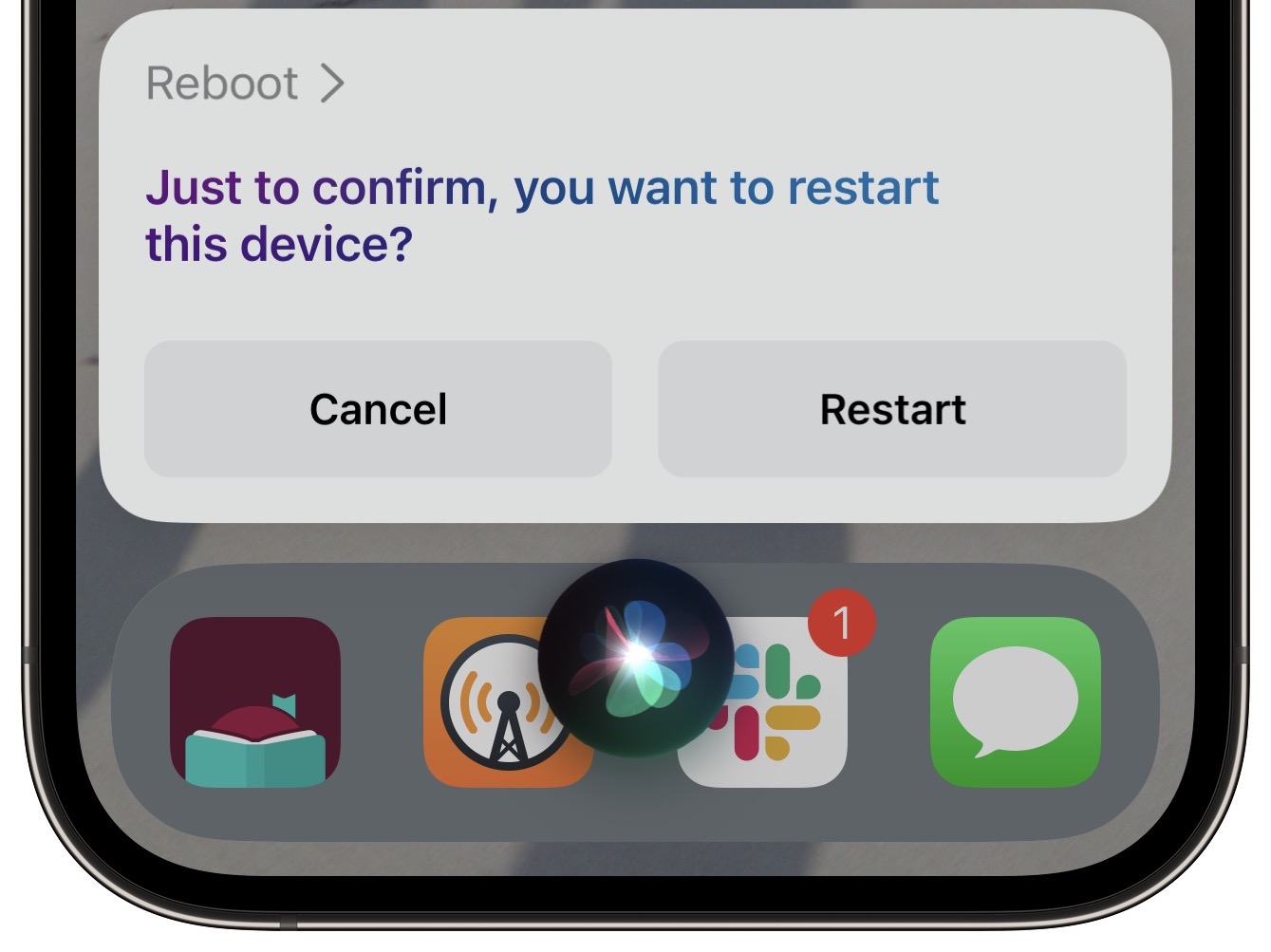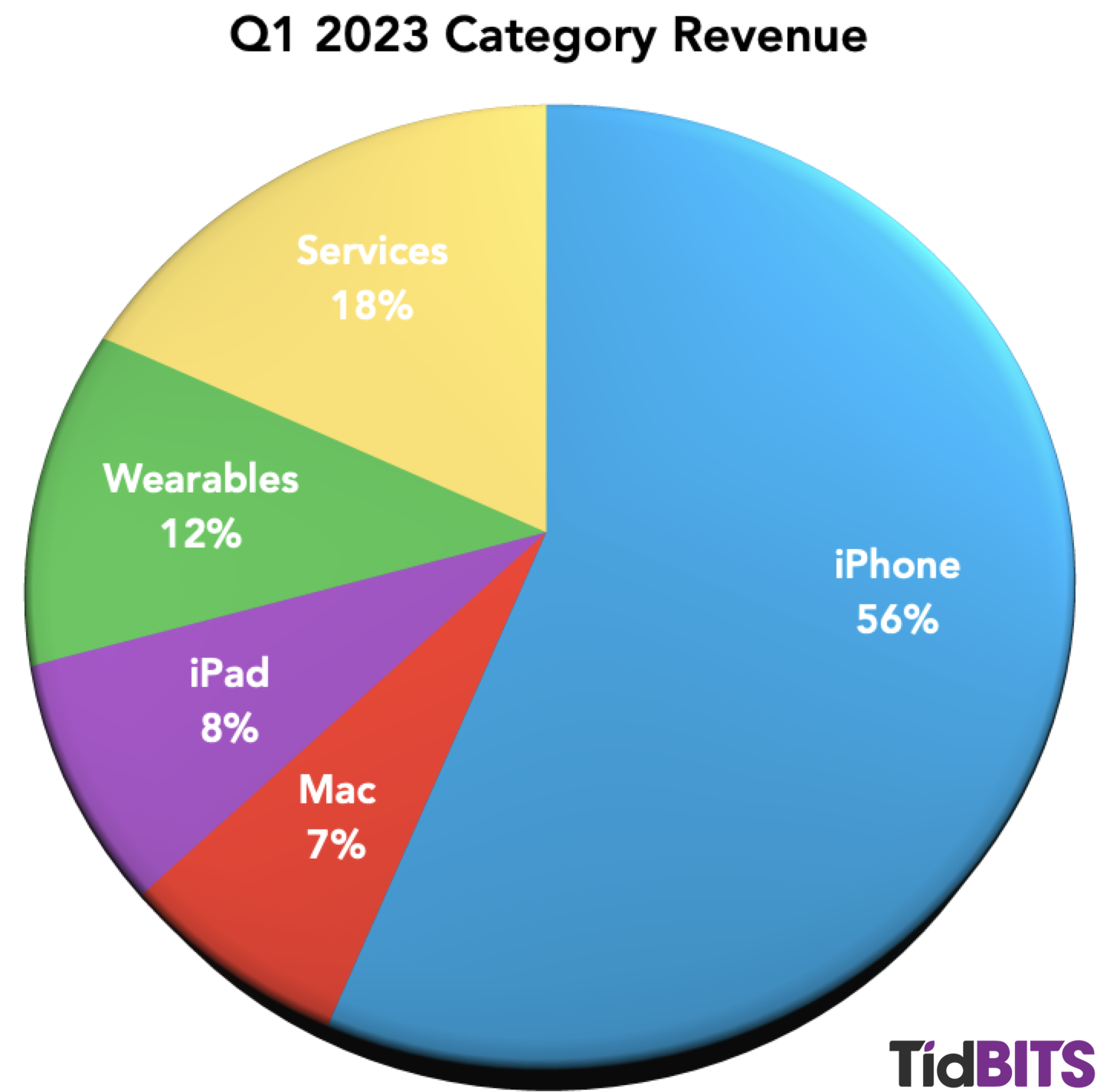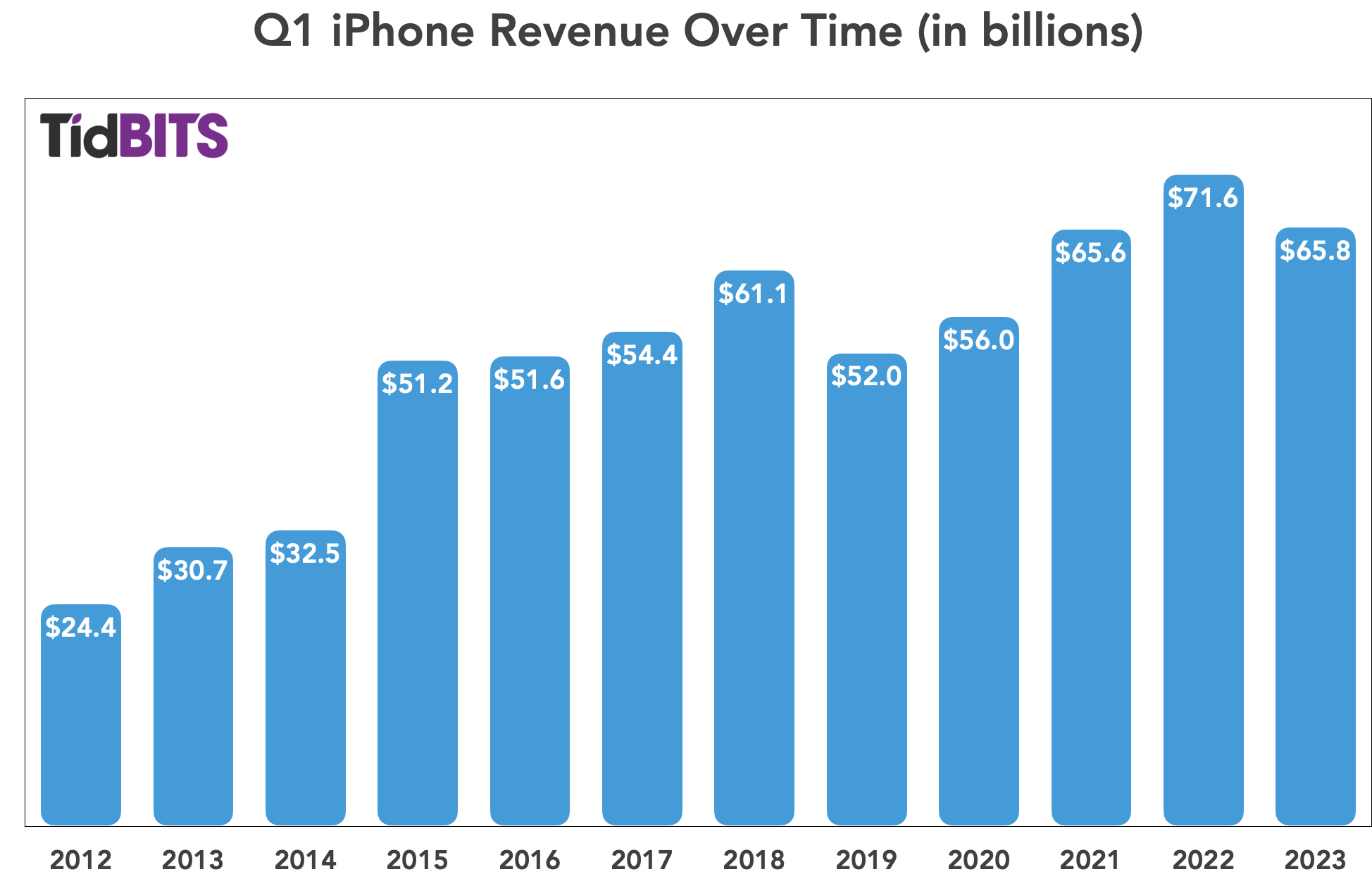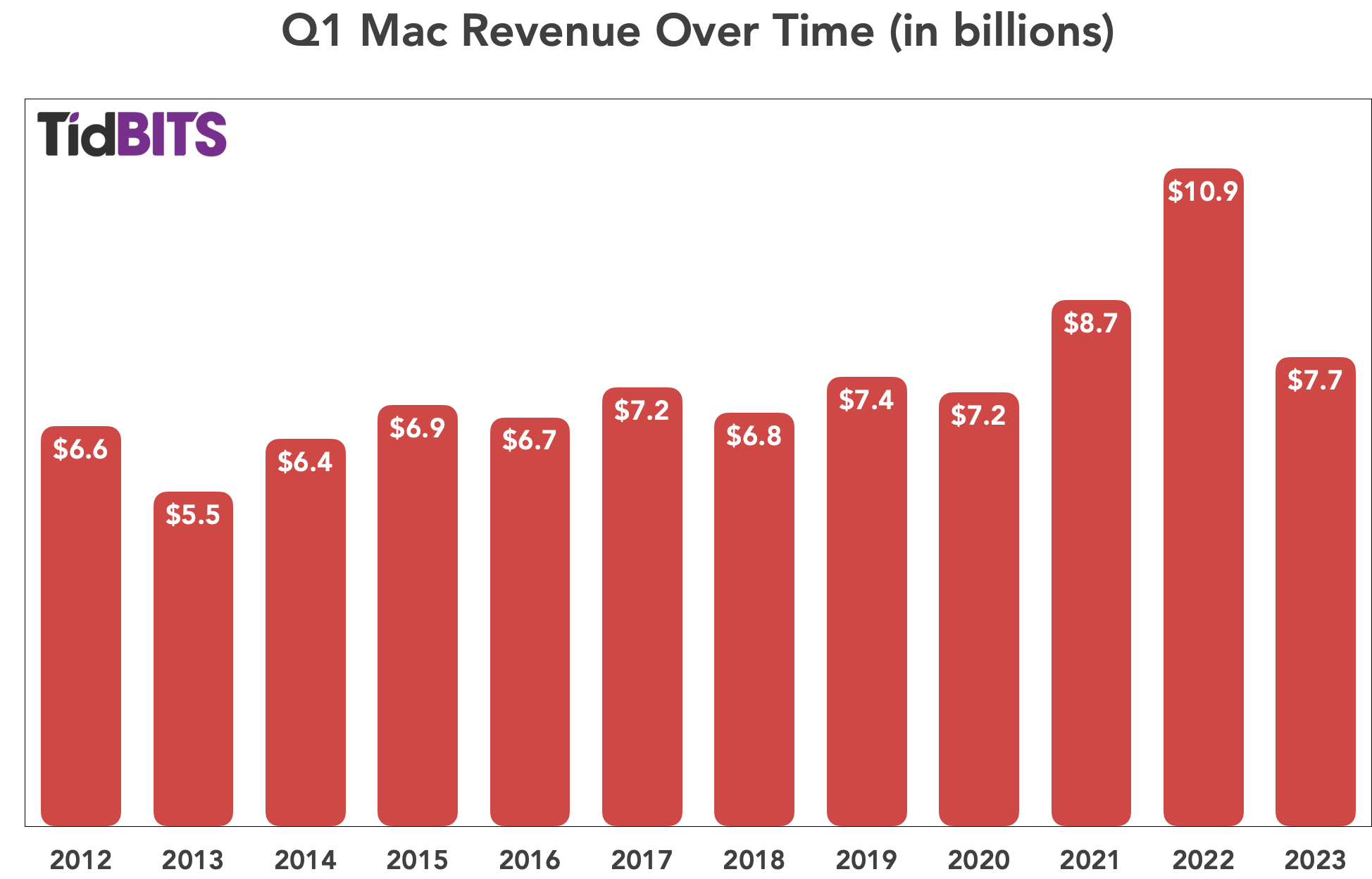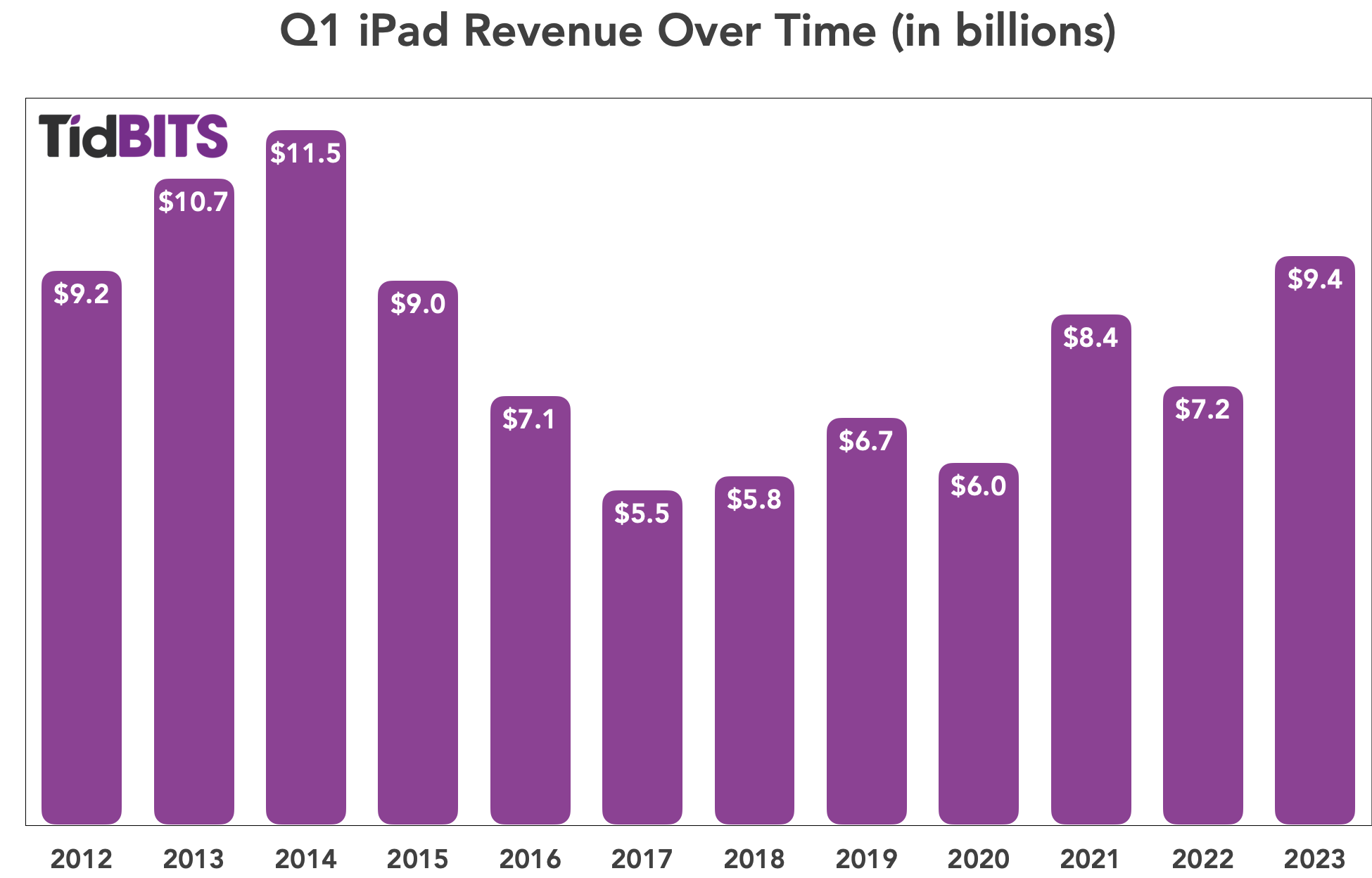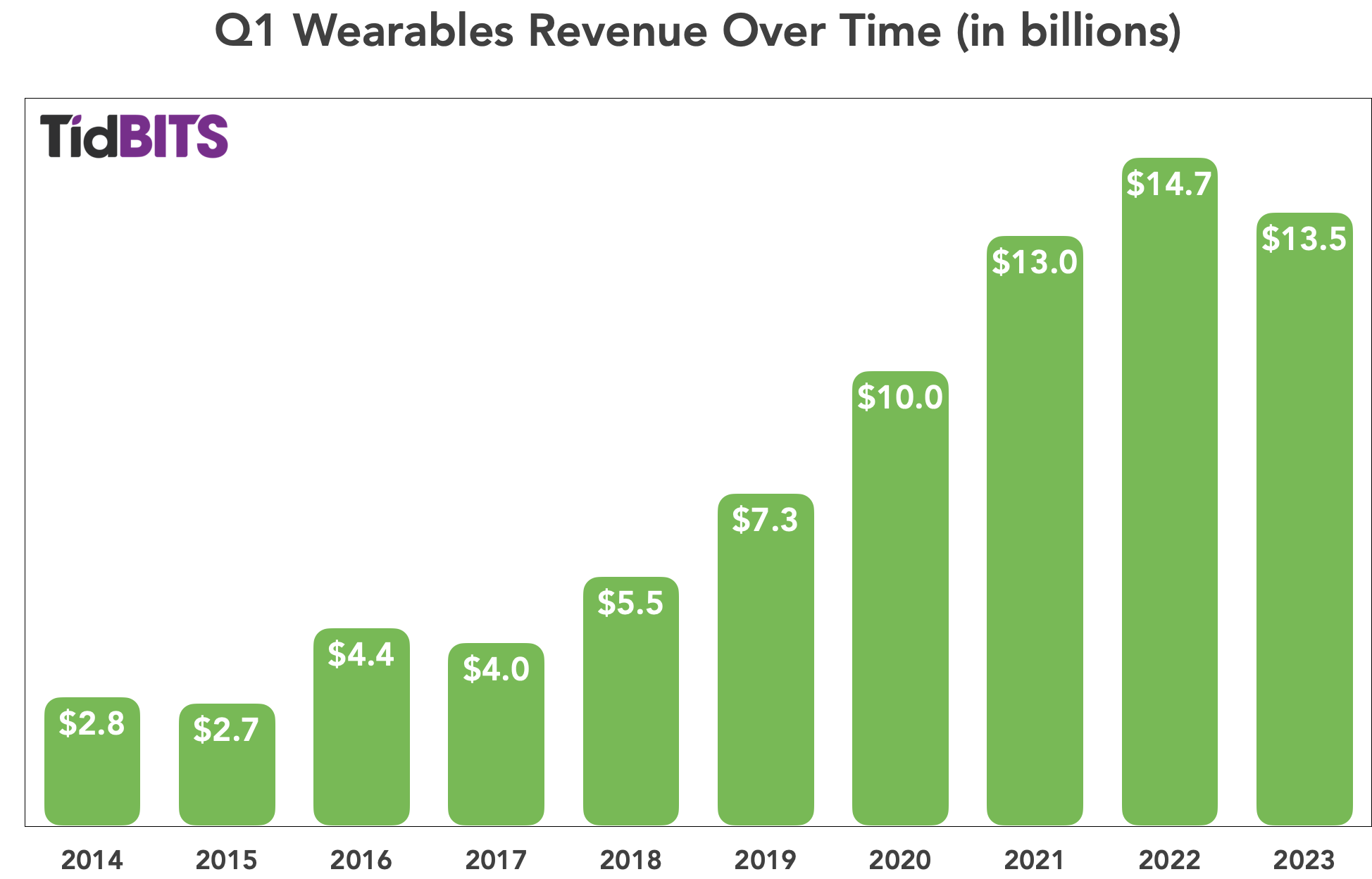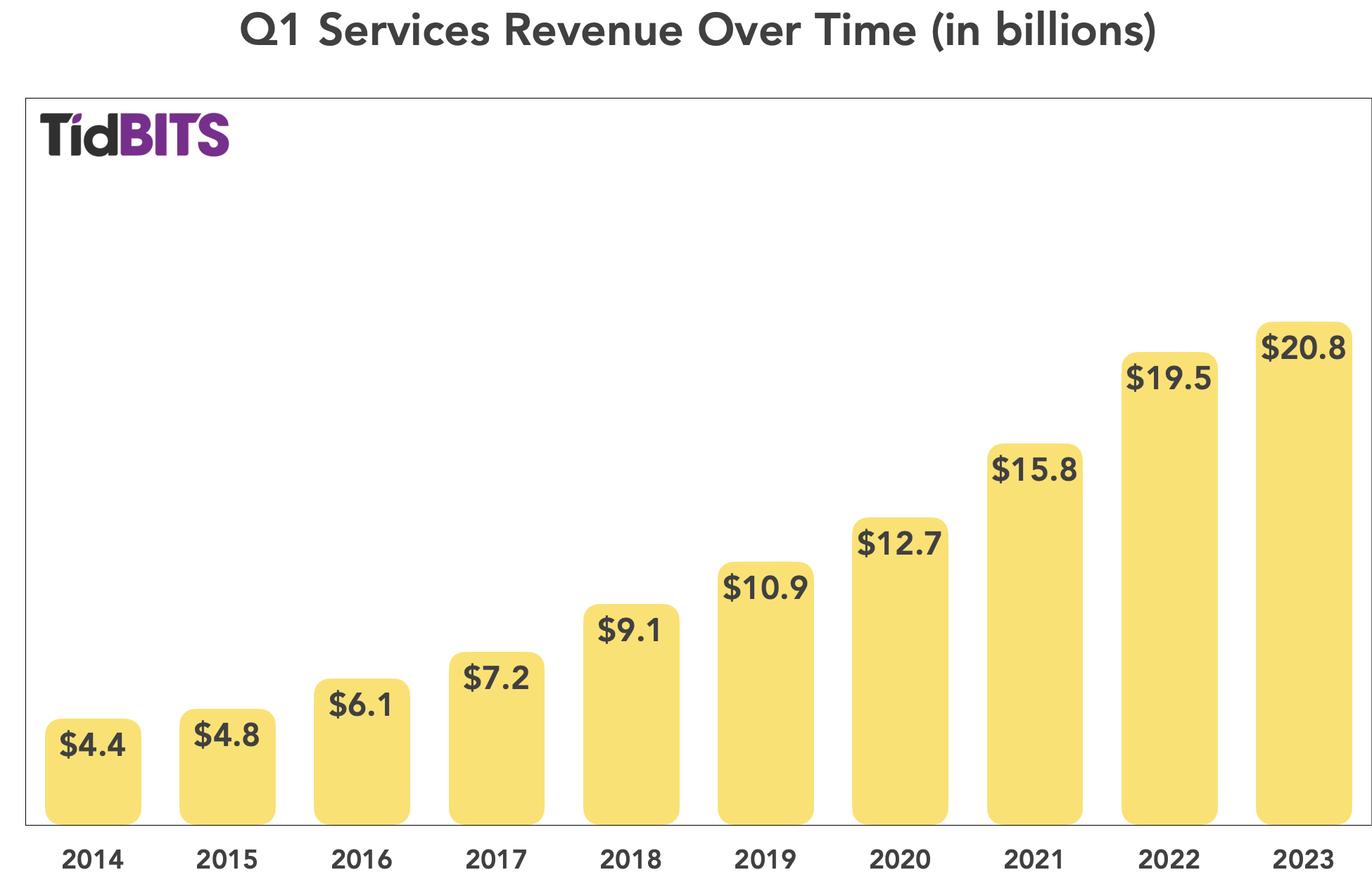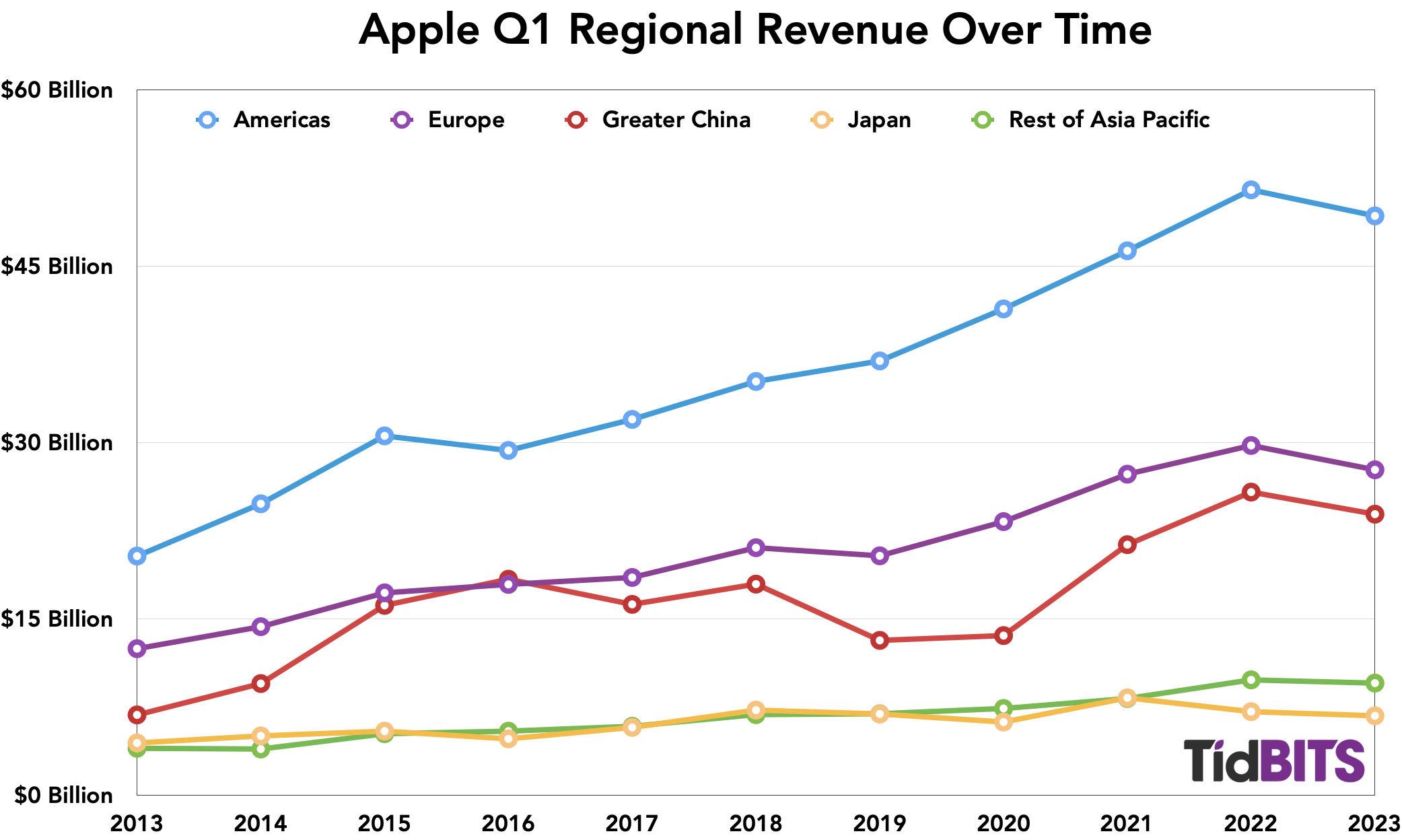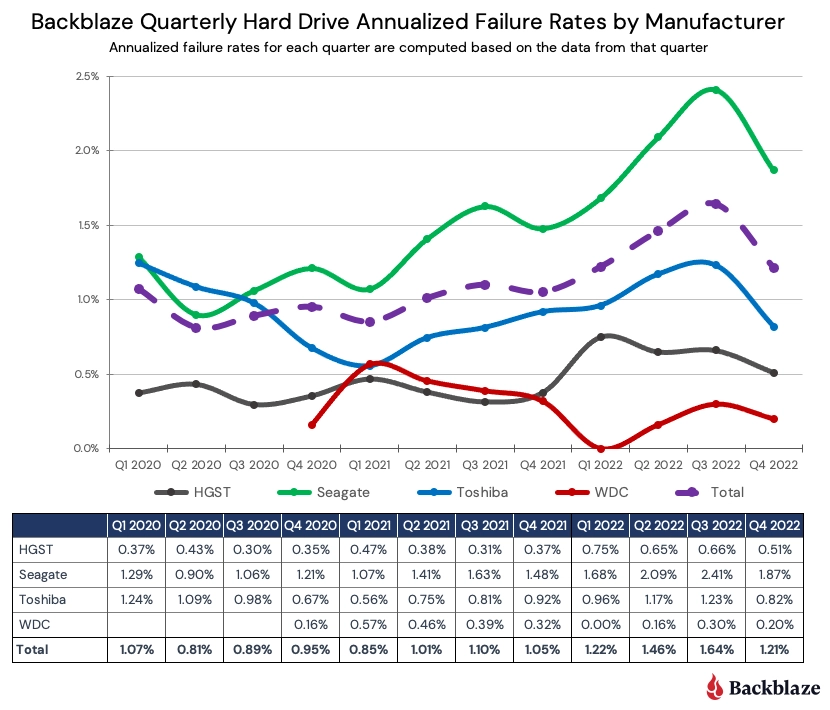#1645: AirPlay iPhone to Mac for remote video, Siri learns to restart iPhones, Apple’s Q1 2023 financials
This week’s issue leads off with Adam Engst’s Christmas story of how he used thousands of dollars of Apple technology to locate a dead mouse. Not a computer mouse, but a flesh-and-blood mouse that had died somewhere underneath built-in shelves and begun emitting a foul stench. Adam also shares a tip about using Siri to reboot an iPhone or iPad, along with some musings on the feature’s cinematic future. Finally, Michael Cohen covers Apple’s Q1 2023 earnings call, where Tim Cook talked a lot about “foreign exchange headwinds” and a “challenging macroeconomic environment” en route to explaining why Apple’s still-massive revenues and profits weren’t as high as they were in the first quarter of last year. Notable Mac app releases this week include RapidWeaver Classic 9.0, Timing 2023.1.3, iStat Menus 6.7, and BusyCal 2023.1.3.
Hunting for a Dead Mouse: AirPlay Receiver to the Rescue
‘Twas the night before Christmas, when all thro’ the house, not a creature was stirring, not even a mouse. Specifically, not the flesh-and-blood mouse that had died somewhere under the built-in counters in our laundry room and was starting to smell. It had been just a nagging whiff in the morning, but the smell had grown stronger by the time we arrived home from my parents’ house on Christmas Eve. A look through all the easily accessible nooks and crannies revealed nothing, and my nose was unable to pinpoint the location of the smell. We closed the laundry room door to keep the odor from spreading and went to bed.
The next day was Christmas out at my parents’ house again, so I put the problem out of my mind… until we got home late that night, by which time the smell had grown into a stench. Another, more thorough pass confirmed that I would have to pull the laundry room apart the next day, preferably before a high school friend and his wife arrived for brunch. Again, we shut the door on the smell and went to bed.
Bright and early on Boxing Day, my son Tristan and I removed the countertop that covers some shelves, laundry-sorting cubbies, and the washing machine (we were not happy when our previous washer died and we learned that all the replacement washers of a similar capacity had become 3 inches taller—the current one is significantly smaller just because of the countertop). Unfortunately, peering down into the space behind everything revealed nothing beyond odorless dust bunnies. Nor was there any evidence of a dead mouse underneath the washer itself. Our friends were due to arrive any minute, so we closed the door on the problem one more time and went off to make brunch.
Afterward, Tristan and I contemplated the problem anew. We were pretty sure there was a dead mouse under one of the shelves, but they were sealed from the front, and there was only about 3 inches of space behind them—far too little to see into the dark underside of the shelves from behind. I had a little mirror on an extendable handle for such situations, but it wasn’t nearly long enough, and getting light under there was going to be tricky. Without knowing more, we’d have to rip apart all the built-in shelves, which would be difficult and likely result in non-trivial damage to the walls, shelves, or both.
Then the solution squeaked into my brain. A week earlier, I had wanted to see what was going on with my running form while I was on a treadmill and could adjust based on what I was seeing. In a class long ago, the instructor had made that possible with a monitor the runner could see, wired to a camcorder behind the treadmill. I remembered that Apple had enabled Macs running macOS 12 Monterey or later to act as an AirPlay receiver for audio or video broadcast from an iPhone or iPad. When Josh Centers wrote about the feature for TidBITS last year, I felt our examples were somewhat lame, but I couldn’t think of better ones (see “How to AirPlay to Your Mac,” 15 August 2022). But this was the perfect use! I set up my iPhone 14 Pro on a tripod behind the treadmill, put my M1 MacBook Air on the treadmill’s shelf, and used the Screen Mirroring button in Control Center on my iPhone to send its video to the MacBook Air. It worked like a charm.
Luckily, a while back, I had purchased an inexpensive ATUMTEK selfie stick/tripod for a video project I was working on. It has a clever design that extends to 31 inches (0.8 m) and holds the iPhone securely. I opened the Camera app, switched to Video, swiped up on the image to reveal the controls, tapped the flash button, and locked the setting to Flash On to provide light.
Then I started screen mirroring to the MacBook Air and had Tristan watch while I craned over the disassembled counter and maneuvered the iPhone so its camera could see underneath the shelves. It worked perfectly, and I felt like a treasure hunter manipulating a remote-sensing device in an ancient catacomb.
The first two spots I checked were empty, but underneath the final set of shelves, I hit gold. Or, rather, what I was pretty sure was the tomb of the unknown mouse.
After a wee bit of jubilation—we had been striking out pretty completely up to this point—we set our minds to figuring out how to remove the mouse nest and carcass. After some unsuccessful disassembly of the shelves in question due to a hidden wall attachment point, I discovered that I could raise the shelf a tiny bit with a pry bar, though not enough to slide anything under to push the nest back to where we could reach it. Throwing subtlety to the winds, I brought in my shop vac, the motor of which detaches to become a leaf blower. A couple of short blasts into the raised front of the shelf had the desired effect (and then some—bleah!), after which we reassembled the shop vac to suck up everything we’d dislodged.
All’s well that ends well, but this odoriferous problem only worked out that way thanks to the application of significant amounts of Apple technology. The next time you need to see around corners and into dark spaces, consider the combination of an iPhone and Mac connected through AirPlay.
TipBITS: Restart Your iPhone or iPad Using Siri
Restarting your iPhone or iPad isn’t something you should have to do often, but there are times when it’s a good troubleshooting step to eliminate odd or problematic behavior. There’s no harm in restarting, apart from a short downtime. But you may not remember which buttons to press to restart your iPhone or iPad (which is really powering the device off and back on, not a true restart). Plus, not everyone may have realized that Apple added an option to power the device off in Settings > General > Shut Down.
In iOS 16 and iPadOS 16, Apple has made restarting significantly easier by bestowing Siri with that capability. Just invoke Siri by holding down the side button or Home button, and then say, “Reboot.” Siri also understands “Restart this device,” “Restart my iPhone,” and so on, although using “Restart” on its own tends to cause whatever audio was playing previously to start again. You can also restart your device hands-free with “Hey Siri, reboot,” but your command could be picked up by multiple devices within range, which might not be desirable. Regardless of how it’s invoked, Siri always asks if you’re sure that you want to restart, and you can either tap the Restart button or answer “Yes.”
That makes me wonder if someone could cause all the iPhones in a crowded room to restart by yelling, “Hey Siri, reboot,” and following it up with “Yes” a few seconds later. Very little actual harm would result, but it would freak people out. It could be a great distraction technique in a spy flick. And as my train of thought continues, now I’m dying to know if the PA system in an airport could be hijacked and used to play a stream of disruptive “Hey Siri” and “OK Google” commands. In a movie, of course.
Sadly, Siri hasn’t yet gained the capability to restart other Apple devices. It’s easy enough to restart a Mac by choosing Restart from the Apple menu (among quite a few other methods), but it would be actively useful if Siri could restart an Apple TV, Apple Watch, or HomePod. Instead, here’s what you must do to restart each of them:
- Apple TV: I can never remember the keys to press on the remote to restart an Apple TV because there are so many buttons and the specific combinations to restart have changed three times (currently, hold down the Back and TV/Control Center buttons). I often resort to selecting Settings > System > Restart and will admit to pulling the power once when I got frustrated.
- Apple Watch: The Apple Watch is more obvious because it has fewer buttons. Restart it by holding down the side button until the sliders appear, tapping the power icon, and dragging the Power Off slider to the right. Alternatively, navigate to Settings > General > Shut Down. Either way, turn it on again by holding the side button until the Apple logo appears.
- HomePod: The only way to restart a HomePod is by touching and holding its tile in the Home app, scrolling down and tapping the gear icon, tapping Reset HomePod at the very bottom of the settings, and finally tapping Restart HomePod. Instead, I usually just unplug it, wait a few seconds, and plug it back in.
Finally, I wonder how the fact that Siri learned to restart iPhones and iPads in iOS 16 first became known. I don’t remember Apple mentioning it in a keynote, and Apple’s coverage of Siri commands doesn’t seem to include it. The first article about it that I can find is dated two days after iOS 16’s release, on 14 September 2022, and comes from a site I’d never heard of called wccftech.com. After that date, lots of sites mention the feature, but did wccftech.com discover it, publish it first, or merely backdate its coverage?
Apple Q1 2023 Revenues Slowed by Exchange Rates, COVID, and Inflation
For only the second time in the last decade (see “Apple’s Q1 2019 Results: iPhone Bad, the Rest Good,” 29 January 2019), Apple has reported first-quarter revenues that have fallen below its results from the year-ago quarter. To be clear, that’s not a loss—Apple still raked in billions of dollars in revenues and profits, just a little less of each than it did this time last year.
In its Q1 2023 financial results report, Apple announced profits of just under $30 billion ($1.88 per diluted share) on revenues of $117.2 billion. The company’s quarterly revenue results are down 5% compared to the year-ago quarter, with profits down 13.3% (see “Apple Posts Record-Breaking Q1 2022 Despite Supply Constraints,” 27 January 2022).
Apple CEO Tim Cook said that the overall revenue drop had three main causes:
- Foreign exchange headwinds: These “headwinds” have to do with currency exchange rates against the strong dollar as Apple buys materials and sells products, but Cook took pains to point out that, on a “constant currency basis,” quarterly revenues would have been up 3%, rather than down 5%. Being a global business can be tricky.
- COVID-19–related constraints: China’s zero-COVID policy caused significant lockdowns that prevented Apple’s subcontractors from producing sufficient iPhone 14 Pro and iPhone 14 Pro Max models, significantly delaying ship times. Cook said those manufacturing constraints have now eased. Lockdowns also caused retail sales in China to drop significantly in November, but sales recovered in December.
- Challenging macroeconomic environment: It’s hard to argue with what Apple is up against here, including inflation, the Russian invasion of Ukraine, and, as Cook put it, “the enduring impacts of the pandemic.”
Overall, the iPhone remained the engine of Apple’s revenue train with 56% of revenues, but that was down 2% compared to Q1 2022, with Services taking over that part of the pie. Wearables remained flat at 12%, and the iPad and Mac made up the remaining 15%, though they flip-flopped by 2% from last year’s first quarter, with the iPad gaining and the Mac dropping.
iPhone
iPhone revenues were depressed compared to last year’s first quarter figures largely because Apple had fewer to sell. Supply chain problems especially affected the costly iPhone 14 Pro and iPhone Pro Max, which have reportedly been more popular than the less expensive iPhone 14 and iPhone 14 Plus. We must note, however, that the first-quarter revenue figure this year is still the second-highest ever in the quarter.
Mac
Mac revenues suffered badly compared to last year’s first quarter figures, dropping 29%. Sad though the news is, it surprised no one: last year saw the launch of the 14-inch and 16-inch MacBook Pro models with the new M1 Pro and M1 Max chips. Those expensive machines proved extremely popular with those looking for even more power than offered by the smaller M1-based MacBook Air and MacBook Pro models that preceded them. Apple had no new Macs last quarter, and worse, plenty of people were probably waiting for the M2 Pro and M2 Max MacBook Pro models that shipped just a few weeks ago (see “New Mac mini and MacBook Pro Models Powered by M2 Pro and M2 Max,” 18 January 2023). Apple expects to see Mac sales challenges in the short term, as it shares in the current sales contraction affecting the general computer market, but Cook said that Apple’s new chips and healthy installed base leave Macs strategically well-placed as that market improves.
iPad
Somewhat unexpectedly, the iPad had a stellar quarter, with revenues up 30% over last year’s first quarter. Apple said the growth was due in part to the release of the tenth-generation iPad and M2 iPad Pro models driving demand. Plus, in Q1 2022, iPad sales were hit hard by supply constraints, whereas Apple was able to meet the demand for new iPads this year.
Wearables
This category includes everything from Apple Watch bands to cables to HomePods (the category appears as “Wearables, Home and Accessories” in Apple’s Consolidated Statement of Operations). Though quarterly revenues were down 8% year-over-year, Wearables still managed to achieve its second-highest Q1 revenue since the category appeared. With the success of the Apple Watch and the return of the second-generation HomePod, a rebound seems likely.
Services
Another bright spot in Apple’s earnings report came from Services, which grew more than 6% year-over-year. Services revenue hit all-time records in the Americas, Europe, and the rest of Asia-Pacific, and set a Q1 record in Greater China. On top of that, cloud services, payment services, and music hit all-time revenue records, along with Q1 records for the App Store and AppleCare. The importance of Services in Apple’s overall revenue mix is clear—the category isn’t affected by supply constraints and enjoys a 71% gross margin, compared to the 37% gross margin for physical products.
Regions
Although Apple saw revenue declines in all geographic segments, led by drops of 7.3% in Greater China and 7.0% in Europe, Cook pointed out some individual bright spots. Apple set all-time revenue records in Canada, Indonesia, Mexico, Spain, Turkey, and Vietnam, and Q1 records in Brazil and India, two huge emerging markets.
Lurking behind Apple’s prospects for the future is a milestone the company reached this last quarter: Apple now has 2 billion active devices roaming the Earth, up 150 million in the last year. Moreover, Apple has doubled the number of its devices in use across the planet in just 7 years. As Apple CFO Luca Maestri noted, the growth of the installed base drives the growth in Apple’s Services revenues, and Services revenue growth was one of the brightest spots in Apple’s quarterly report, thanks in large part to the number of active subscriptions reaching 935 million.
Finally, Apple’s bad-but-not-that-bad first-quarter results need to be viewed against the performance of the rest of the tech industry. For example, Apple is the only tech giant not to announce major layoffs in recent months (see “Apple Avoids Big Tech Layoffs, Other Tech Giants Focus on AI,” 20 January 2023). Apple may have been facing, and may well continue to face, strong headwinds, but it seems better able than most to tack into them.
